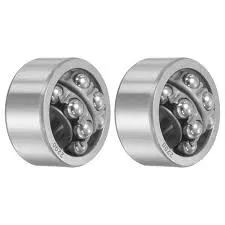
Nov . 22, 2024 03:40 Back to list
angular contact ball bearing size chart
Understanding Angular Contact Ball Bearings A Size Chart Guide
Angular contact ball bearings are a crucial component in various mechanical systems, particularly in applications where high-speed operation and axial loads are present. These bearings are designed to accommodate both radial loads and axial loads, allowing them to perform effectively in a range of engineering scenarios. In this article, we will explore the importance of angular contact ball bearings, their features, and how to navigate a size chart for these components.
What Are Angular Contact Ball Bearings?
Angular contact ball bearings consist of inner and outer raceways that are angled relative to the bearing axis. This angled design allows them to handle axial loads in one direction while also supporting radial loads, making them versatile for different applications. The ability to accommodate axial loads in one direction means that they are particularly useful in scenarios where space is limited, and where shafts may experience significant loads from different angles.
Key Features of Angular Contact Ball Bearings
1. Load Handling As mentioned, angular contact bearings can take on both radial and axial loads. The load rating of these bearings varies depending on the angle of the bearing contact and the number of balls within the assembly. 2. Contact Angle The contact angle in angular contact bearings varies from 15 to 40 degrees, which can be tailored to specific application requirements. A larger contact angle allows for higher axial load capacities but may reduce the radial load capacity.
3. Precision and Speed These bearings are designed for high-speed applications. They are typically used in machine tooling, automotive transmission systems, and electrical motors. The precision design means that they can sustain high RPM without overheating or causing operational failure.
4. Mounting Configurations In applications needing radial and axial load support from both directions, bearings can be arranged in pairs, either back-to-back or face-to-face, to form a more robust support system.
Navigating an Angular Contact Ball Bearing Size Chart
Understanding the size chart for angular contact ball bearings is essential for choosing the right component for your specific application. Size charts typically include several key parameters
1. Inner Diameter (ID) This measurement indicates the bore size of the bearing and is critical for ensuring that the bearing fits onto the shaft correctly.
angular contact ball bearing size chart

2. Outer Diameter (OD) The outer diameter is important for determining how the bearing fits into the housing or support structure.
4. Contact Angle Size charts often indicate the contact angle, which helps determine the bearing's application suitability based on the expected load conditions.
5. Dynamic Load Rating (C) This rating helps to understand how much load the bearing can handle dynamically (while in motion).
6. Static Load Rating (C0) This rating is crucial for understanding the maximum load the bearing can handle when stationary.
7. Speed Ratings (n) Speed ratings indicate the maximum acceptable speed at which the bearing can efficiently operate without failure.
Choosing the Right Bearing
When selecting an angular contact ball bearing, it’s important to consider all the parameters provided in the size chart along with your specific application requirements. Factors such as load conditions, operating speed, and alignment freedoms should all be taken into account.
For example, in high-speed applications where axial and radial loads are significant, you may opt for a bearing with a higher contact angle and a dynamic load rating that matches your specific needs. Conversely, for applications requiring greater rigidity and precision, a bearing with a smaller contact angle may be preferred.
Conclusion
In conclusion, angular contact ball bearings are essential for a wide range of mechanical applications due to their ability to support both radial and axial loads efficiently. Understanding how to read and interpret size charts will enable engineers and technicians to make informed decisions, optimizing performance and longevity in mechanical design. By selecting the right bearing based on the size chart parameters, organizations can ensure that their systems operate smoothly and reliably.
Latest news
-
Grooved Ball Bearing Design and Functionality
NewsJun.04,2025
-
Concrete Mixer Bearing Load Capacity Testing
NewsJun.04,2025
-
6004 Bearing Dimensions in Robotic Joint Designs
NewsJun.04,2025
-
Advantages of Single-Row Deep Groove Ball Bearings
NewsJun.04,2025
-
Applications of Deep Groove Ball Bearings in Automotive Systems
NewsJun.04,2025
-
Innovations in Bearing Pressing Machine Design
NewsJun.04,2025
